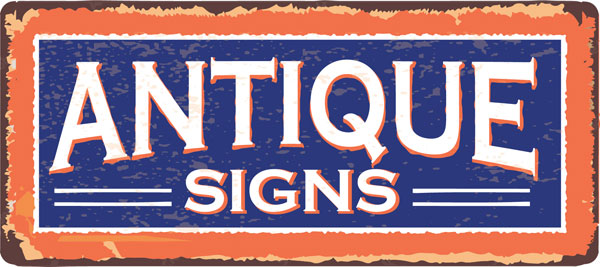The most valuable enamel signs sold at auction in Australia
What started out as a cool hobby has turned into a financial juggernaut, thanks to the influence of popular antique and auction reality shows.
Vintage enamel signs, once the realm of enthusiasts, are now a hot trend, and there’s a good reason why.
As replicas and restored signs find their way into homes, businesses and man caves, the demand for genuine vintage signs has gone through the roof. A 2022 sale broke the US$1.5 million mark! This was for a 48-inch double-sided porcelain Musgo Gasoline sign – a one-of-a-kind collectible in mint condition.

While not every sign reaches those stratospheric prices (at least not yet), rare or beloved signs in good condition can easily command 4 or 5 figures, even in smaller regional markets like Australia.
Here’s a peek into some of the more valuable signs that have crossed the auction block in Australia.
Castrol Wakefield Motor Oil
Let’s dive into the legendary history of Castrol, a name that’s been revving engines since 1899.
Back in the day, they went by ‘CC Wakefield & Company’, and founder Charles Wakefield was heavily into early cars and planes. In 1906, they produced their first automotive lubricants, paving the way for greatness, and one day reaching all the way to Mars!
How did they get the name ‘Castrol’? Well, here’s the deal. They figured out that adding a measure of castor oil to their lubricants made them thick enough to handle the sizzling temperatures of those early engines, yet still slick enough to work during a chilly start-up.
But they weren’t just making an awesome product. They knew how to market it too! Castrol kicked off a massive advertising campaign, sponsoring all kinds of automotive and aviation events and, of course, cranking out some seriously epic signs.
Fast forward to 1960, and the company decided to change their name to reflect their flagship product, hence ‘Castrol Ltd’. But guess what? Those vintage Wakefield signs are still out there, and today are considered a very desirable piece of automotive history.
Take, for example, this Wakefield Motor Oil sign that raked in a jaw-dropping $12,600 AUD at auction. That’s the kind of treasure you want hanging in your man cave!

Veedol Motor Oil
Henry Ford himself chose Veedol Motor Oil, a classic in the car lubrication game, for his Ford Model T, one of the earliest mass-produced cars.
It also had a role in significant feats, like powering the Graf Zeppelin, the first airship to circumnavigate the globe, and even powered the ‘Miss Veedol’, the first aeroplane to fly non-stop across the Pacific. Heck, Veedol even hitched a ride on the Columbia space shuttle!
With a history like that, it’s no wonder Veedol is hot stuff among collectors. Case in point: a Veedol Motor Oil enamel sign reached a cool $17,500 AUD at auction.

Mobilubrication, Vacuum Oil Company
The Vacuum Oil Company has been in the oil game since 1866, and it’s still going strong today under a fancier name – ‘Exxon Mobil’.
But here’s the twist. But here’s the twist. Over the years, it’s had more ups and downs than a rollercoaster. The frequent name changes and corporate shenanigans (conspiracies, bribes and sabotage, no less) produced a tonne of signage, and the collector’s world is buzzing about it.
This Mobilubrication sign from back in the day? It just pocketed someone a smooth $19,000 AUD.

The Sun News Pictorial
Melbourne’s Herald Sun newspaper has been making headlines for over a century. It started its journey as the tabloid Sun News Pictorial in 1922 and quickly became the hottest paper around, known for its big photo stories, cartoons, fascination with crime and prolific footy coverage.
It’s still in the game, joining forces with the Herald newspaper in 1990.
And those early ads from the Sun News Pictorial era? They’re like a piece of Melbourne’s soul, and worth a hefty price tag – $20,500 AUD to be exact.

Blue Shell Stickman
Shell is a big deal. Started in London in 1833, the company initially imported seashells. But after the founder, Marcus Samuel, died, his sons turned to oil transport in the 1880s.
Their initial 3 tankers – named Murex, Conch and Clam – became the forerunners of today’s Royal Dutch Shell company.
But it was the company’s iconic logo and snazzy colours of their advertising signs that rocked the petroleum world. Unusually, many of the enamel signs for their petroleum products forgo the traditionally white base, instead sticking to their largely red and yellow livery.
But Shell’s signs are pure gold for collectors. A rare blue Shell sign sold for $38,100 AUD.

Alba Motor Spirit
Here’s another Aussie gem – Alba Motor Spirit. Founded in Melbourne in 1933, it had a short but sweet run, merging with the Pacific Oil Company and then AMPOL in 1945..
But during its brief time in the spotlight, Alba knocked out a killer logo and colour scheme.
The unique Alba look, and limited run, make their signs a hot item. A top-notch Alba sign sold at auction for a sweet $43,500 AUD. Ka-ching!


